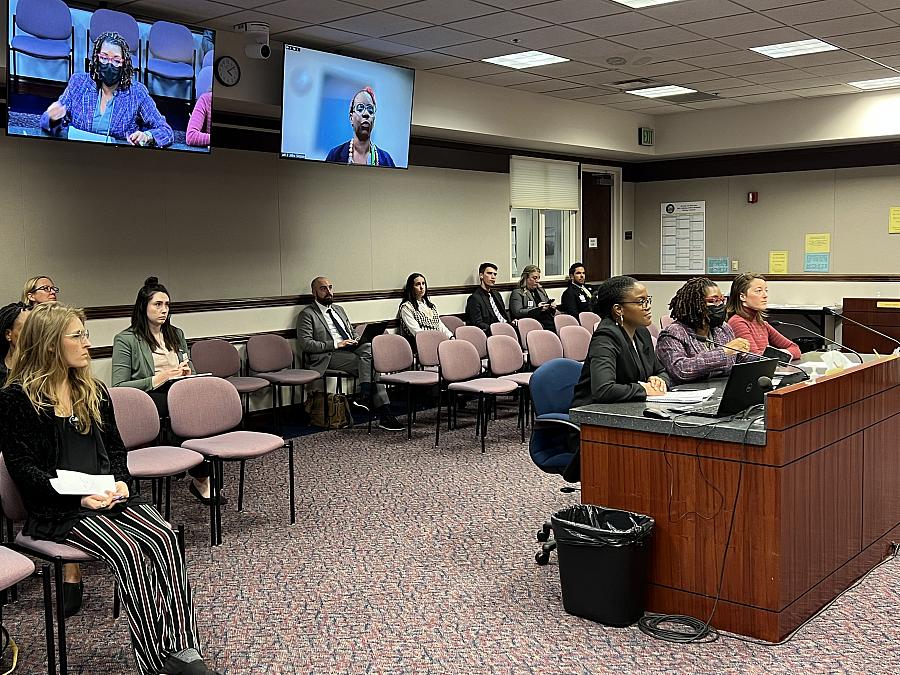In the vast maternal health care deserts of Nevada, a new law offers hope that vital services may bloom

Public health researcher Joyce Abeng (from left), Assemblywoman Shondra Summers-Armstrong (D-Las Vegas), and DOULA CO-OP Executive Director Emily Barney present legislation to increase Medicaid reimbursements for doulas in Carson City, Nev. on March 22, 2023.
Lucia Starbuck / KUNR Public Radio
More than half of Nevada’s 17 counties do not have a hospital or birth center that offers obstetric care, so rural families must travel hours to receive services, or forgo care.
The state’s capital, Carson City, has the highest infant mortality rate per capita and has the closest hospital with obstetric care for many rural patients. In urban Reno, one of the region’s large hospital systems abruptly closed its maternity ward at the end of 2022.
For the USC Center for Health Journalism 2023 National Fellowship, I will explore the correlation between infant mortality rates and the availability of prenatal and postpartum care in the state.
A new law may help fill the gap in this section of health care. The law more than triples the reimbursement rate for doulas who care for patients insured under Medicaid, with higher incentives for rural providers.
Doulas are non-medical professionals who provide physical, emotional and spiritual support to pregnant people and their families before, during and shortly after childbirth. Pregnant people who utilize doula services are less likely to have birth complications, such as a low birth weight baby and cesarean birth, and are more likely to initiate breastfeeding. Doula care has been shown to lower rates of maternal mortality and morbidity and may reduce racial health disparities by ensuring that people most likely to face discrimination and mistreatment in the medical system receive the support and care they need.
Doulas became eligible to provide care under Medicaid in Nevada in April 2022. However, as of March 2023, only six had enrolled — in no small part, advocates say, because reimbursement rates were set so low.
DOULA CO-OP, a non-profit based in Reno that advocates for equitable access to doula services, pushed hard for the reimbursement hike.
“That’s everything that we could have wanted from our legislators, from the people who are making policy,” said Emily Barney, a birth, postpartum and death doula and the organization’s executive director.
Doulas will no longer have to choose between private insured clients who can afford their full fees or caring for low-income patients on Medicaid, she said.
“It’s a big deal that we now have the opportunity to support the population that otherwise would not have access to these services,” Barney said. “With the support of a doula, that baby has an easier time coming into the world.”
My project, a four-part series, will provide an overview of maternity care disparities in rural Nevada, doula workforce recruitment and retention following the Medicaid reimbursement increase, doula training, and the experience of pregnant people and families who utilize doula services.
The first story will focus on a rural family expecting a baby, and the emotional and financial challenges they face accessing care. The second story will focus on efforts locally, nationally and internationally to increase awareness and access for people interested in the doula and midwife professions.
The third story will examine efforts to diversify doula services and provide culturally sensitive care. Nevada offers unique training opportunities, including a program that allows doulas to shadow one another in a hospital delivery room, and DOULA CO-OP’s efforts to provide Spanish lessons for doulas. This story will also explore how Native American communities, including those in the most remote parts of the state, access maternal care. Native American infants have the third highest mortality rates in the U.S.
The final piece will center on the experiences of a rural family who utilizes a doula: why they chose this path and what they gained from the experience.
